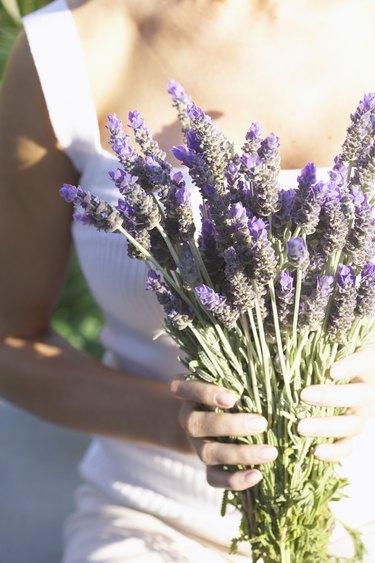
Prized for its fragrant blossoms and foliage, lavender (Lavandula spp.) has been grown in Europe and Mediterranean areas for centuries. It's estimated that more than 40 species of lavender exist and more than 400 varieties, or cultivars. Because of the variability, a wide range in cold hardiness exists, from U.S. Department of Agriculture plant hardiness zones 4 through 11, with differences depending on the species. New Jersey spans USDA zones 6 through 7 and can grow a number of species and varieties.
New Jersey Climate
Video of the Day
Though it's a small state, New Jersey has several different climate zones, affected by the maritime influence of the Atlantic Ocean and by the west-to-east weather flow across the North American continent. The coldest area, USDA zone 6a, is in the mountainous higher-elevation north. The mildest area, USDA zone 7b, is along the central and southern coast next to the ocean. Average annual rainfall ranges from about 40 inches in the southeast to 51 inches in north-central New Jersey.
Video of the Day
Kinds of Lavender
Lavenders are grouped in three basic categories: English, non-English and lavandins, the last being hybrids between the first two. Strong-scented English lavender (Lavandula angustifolia) is hardy in USDA zones 5 through 11, with one of its varieties, "Munstead," tolerating USDA zone 4. Non-English lavenders are not as fragrant and are generally hardy in USDA zones 8 through 11. The hybrid lavendins combine the qualities of English lavender and spike lavender (Lavandula latifolia) and are very fragrant, decorative plants that are more drought- and heat-tolerant than English lavender but less cold-hardy. A farm in Port Murray, New Jersey, grows 75 different kinds of lavender, and a lavender farm in Morganville, New Jersey, grows English lavender as well as numerous lavendins.
Garden Plants
Depending on where you live in New Jersey, different soil types exist. Much of New Jersey has clay soils on the acid side, and southern New Jersey has sandy soil. Lavenders prefer very well-draining, slightly alkaline soils between pH 7 and 7.5. Acid soils need amendment to make them more alkaline, by adding lime. Texas A&M University recommends adding 8 pounds of dolomite per cubic yard of soil to raise the pH value by one unit. To increase soil drainage, add well-aged organic material, or create raised beds to ensure good drainage. New Jersey growers have success by watering lavender during the first year it's planted and then letting the plants subsist on natural rainfall.
Container Plants
You have the option of growing lavender in containers so that you can control the drainage and the soil type and which also allows growing more tender lavenders. Use large pots -- 12-inch- to 16-inch-wide containers -- to accommodate lavender's eventual growth to a fair-sized shrubby plant. Use a high-quality, well-draining potting mix. Add 1 tablespoon of lime and 1/2 cup of 8-8-8 controlled release fertilizer at planting time. Lavender needs at least eight hours of direct sunlight, and it should be allowed to dry between thorough waterings. You can store the pots in an unheated garage or storage shed for the winter, watering them about every two weeks if the soil remains unfrozen.
- Pelindaba Lavender: Lavender Varieties
- National Gardening Association: Edible Landscaping: Edible of the Month: Lavender
- United States Department of Agriculture Agricultural Research Service: USDA Plant Hardiness Zone Map
- Pleasant Valley Lavender: Home
- The New York Times: Home & Garden: Provence in a Plant: Just Inhale
- Rutgers University: Office of the NJ State Climatologist: NJ Climate Overview: The Climate of New Jersey
- Texas A&M University Aggie Horticulture: Caring for Plants in the Home Q. 1-20
- NJ.com: Star-Ledger: Perennial Lavenders Lend Fragrance to Garden
- Christian Science Monitor: Diggin' It: With These Tips, Anyone Can Grow Lavender